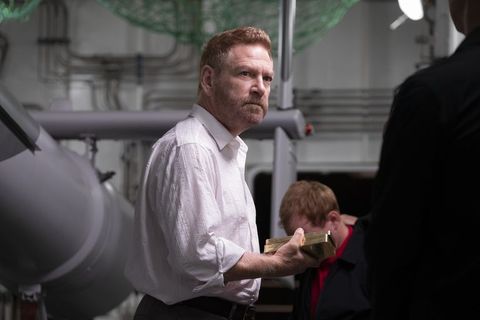Tenet spoilers follow.
Christopher Nolan has always liked to keep the mystery when it comes to his movies, and Tenet has proven to be no exception.
Even after the trailers and marketing, all we really knew about Tenet was that it involved time inversion (not time travel) and it centred on John David Washington's Protagonist, who is drawn into a fight for the entire world's survival.
But what exactly is that mission and what the hell does time inversion have to do with it? We won't pretend to be physics experts, so this won't be a concise deep-dive into the science of Tenet.
What it will be though is an outline of Tenet's plot and, in layman's terms, the general science behind its concept. Needless to say, there are major spoilers ahead so don't read on if you haven't seen it yet.
Seriously, Tenet is something best experienced in the position of how the Protagonist starts the movie, not knowing what the hell he's got himself into.
Essentially, the plot of Tenet boils down to that classic spy movie setup: a bad guy wants to destroy the world and our hero needs to stop him.
It's just that the world in which that mission takes place is more complex and unique than any you've seen in any James Bond movie, or otherwise.
After the prologue sees the Protagonist decide to kill himself instead of give up his team, he's saved by a mysterious individual who welcomes him "to the afterlife", arming him with a single word: Tenet.
This new world he's found himself is is laid out in a conversation with Clémence Poésy's scientist.
There are things that, instead of moving naturally forward in time, are moving backwards in time, including bullets. The fear is that an "inverted weapon" from the future could affect their past, say a nuclear weapon.
The Protagonist tracks these bullets to Andrei Sator (Kenneth Branagh) and uses Sator's abused wife Kat (Elizabeth Debicki) to engineer a meeting, in order to find out who Sator is working with.
He promises Kat that he'll get back some fake art that Sator is using to control Kat - she delivers a monologue about seeing a woman dive off the yacht as she returned, envying her freedom (remember this).
So along with the help of Neil (Robert Pattinson), the Protagonist breaks into a free port in Oslo, Before he can do that though, he gets into a fight with a mysterious inverted individual who gets away (remember them though, it's important).
The Protagonist still gets his meeting with Sator though, by telling him he can help get the plutonium he wants. Sator doesn't trust him and cuts him out, so the Protagonist and Neil work to steal the plutonium before Sator can. A heist within a heist, if you will.
Sator still comes out on top though as he appears during the heist in an inverted car and threatens Kat's life to get the Protagonist to give up the plutonium. It turns out that Sator's team have been doing a "temporal pincer", moving forwards and backwards in time to the heist to ensure they know exactly how it'll all go down.
They do this through the use of a "time stile" (sent from the future, naturally) that allows Sator to invert himself (move backwards through time), but before he goes to get the plutonium from the past version of the Protagonis, he shoots Kat with an inverted bullet.
It's here when things get (even more) trippy. A military unit shows up, led by Ives (Aaron Taylor-Johnson), and it's revealed that Neil has always known more than the Protagonist and is part of the Tenet organisation.
But Sator wasn't after plutonium, it was actually part of an algorithm that will change the world's entropy, effectively putting it in reverse. If Sator uses it, it likely means the end of civilisation.
It turns out that Sator is actually working for people in the future where the world is so destroyed that they "have no choice but to turn back". A scientist made this algorithm to reverse the flow of time, but to stop it being used, she split it into nine pieces and hid it in the past.
The nefarious people in the future recruited Sator in his youth when his hometown was destroyed by a nuclear blast, using him to find all nine pieces and bring them all back together.
To stop Sator and to save Kat's life, the Protagonist, Neil and Ives' team invert themselves and start moving back in time. The Protagonist is warned that he can't meet his past self and he needs special breathing apparatus as he's inverted, but "the world's not".
He's unable to stop Sator as the crashed car he saw earlier during the heist was actually his crashed car in his inverted pursuit. To give Kat time to heal, they make their way to Oslo, as they know there's another of the "time stile" machines there, knowing they can get in when they originally created the diversion.
Yes, you guessed it, the person the Protagonist fought was actually his future self.
Having gone through the machine at the free port, they're now in the past, but moving forward through time normally.
The problem is that Sator plans to activate the algorithm in the past. He's buried it in his former hometown under several bombs. It seems that when they explode, it'll activate the algorithm buried underneath them, changing the entropy of the world.
Kat reveals that Sator is dying of terminal cancer, so using his fitness tracker as a dead man's switch, he plans to kill himself on his luxurious yacht when he knows his past self isn't there, activating the algorithm to destroy the world.
The Protagonist, Neil and Ives set out on a mission to lift the algorithm before the bomb explodes, while Kat heads to the yacht to stop Sator killing himself before they've succeeded.
A mind-bending battle follows where one half of the team is working backwards to the explosion and the other working forwards. The long and short of it is that with Neil's help, the Protagonist and Ives lift the algorithm in time, which is lucky as Kat decided to kill Sator just as they take it.
The woman that past Kat saw jumping off the yacht when she returned on that day was actually her future self after she had killed the future version of Sator.
Unfortunately, for the mission to succeed, the Protagonist realises that Neil is killed when he goes backwards to help them. Once they've escaped with the algorithm, he tries to persuade Neil to not go back, but as he puts it: "What's happened, happened."
Before he goes though, Neil reveals that it's actually the Protagonist who recruited him for Tenet, teasing that "we get up to some stuff".
It's things that are in the Protagonist's future, but Neil's past as the whole 'save the world' mission has been a "temporal pincer". Neil and others have been working back towards it, while others like the Protagonist have been moving forward to it.
And it was all set up in the future by the Protagonist, along with the Tenet organisation itself (presumably).
It's the central concept of Tenet. This isn't a case of changing the past or future, everything has all been a part of the same loop. Sator was never likely to succeed in his mission because he never did.
Whether it's a world in which things can be changed remains to be seen.
After they go back in time to Oslo, the Protagonist tries to get Priya – the arms dealer who told his past self about Sator and the 'plutonium' – to not tell him about it so that Sator would never get his hands on the final algorithm piece.
But she refuses, so we don't know if that could have changed events. In the final moments of the movie, the Protagonist stops Priya from killing Kat to clear up loose ends, but he's only there because of something he told Kat in the past.
Is that something that always happened? Or did the Protagonist alter the future by getting Kat to phone him if she ever thought she was in danger?
It's certainly cleaner for it to be a world where everything happens as it always has, even if you're not entirely clear about it at the time.
As the Protagonist puts it to Neil before they set off to stop Sator: "Doesn't us being here now mean it never happened?"
Tenet is out now in UK cinemas and is released in US cinemas from September 3.
Digital Spy has launched its first-ever digital magazine with exclusive features, interviews, and videos. Access this edition with a 1-month free trial, only on Apple News+.
Interested in Digital Spy's weekly newsletter? Sign up to get it sent straight to your inbox.
This content is created and maintained by a third party, and imported onto this page to help users provide their email addresses. You may be able to find more information about this and similar content at piano.io
2020-08-26 11:01:00Z
https://news.google.com/__i/rss/rd/articles/CBMiTGh0dHBzOi8vd3d3LmRpZ2l0YWxzcHkuY29tL21vdmllcy9hMzM2NTM2NzAvdGVuZXQtZW5kaW5nLWV4cGxhaW5lZC1zcG9pbGVycy_SAQA?oc=5
Bagikan Berita Ini





















0 Response to "Tenet ending explained - unravelling Christopher Nolan's movie - digitalspy.com"
Post a Comment